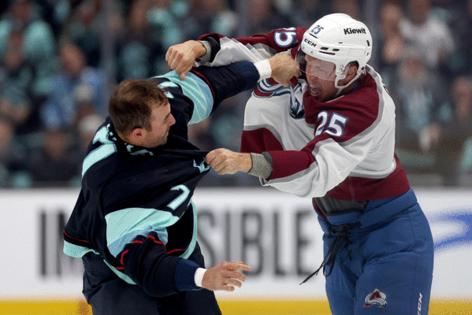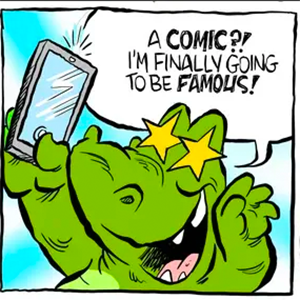Geoff Baker: Hockey's unwritten rules: If you started trouble, you'd better drop the gloves
Published in Hockey
SEATTLE — An old axiom from schoolyards and streets applies equally to NHL rinks: Don't start something you can't finish.
And finishing often involves accepting a challenge to drop your gloves and fight. Dropping gloves is an expected ritual as old as professional hockey itself, especially if a player has laid another one out through a borderline or illegal hit.
"If somebody's been cheap-shotted or hit in the back or something like that and you're the person laying the bad hit, you've got to be ready to throw your gloves off," Kraken forward Jared McCann said. "That's just the way it is."
It's part of the unwritten hockey code — and also the NHL rule book — that gloves come off before punches as the hard padding can elevate damage inflicted. Also, it's seen as accepting the challenge to engage in mutual on-ice combat allowable under NHL rules since 1922; the lone penalty being offsetting five-minute fighting majors.
Still, some buck tradition by refusing to drop gloves and fight. An occasional odd duck will even fake a glove drop to goad an opponent into shedding theirs and earning a two-minute instigator penalty.
The worst transgressors refuse to fight and "turtle" to further sell an instigator penalty — usually dropping to the ice and covering their head in a protective shell-like posture while their gloveless opponent rains down blows. Everybody loves a turtle, except hockey players viewing it among the most cowardly on-ice acts.
"Yeah, it is, big-time," McCann said of "turtling" remaining despised even with hockey fights on the decline. "Especially if you lay a dirty hit, or cheap-shot a guy. You have to answer for it."
Last month, Kraken coach Dave Hakstol was incensed after Calgary Flames forward Martin Pospisil delivered cheap shots on Adam Larsson and Vince Dunn in the same game. Hakstol seemed just as angry postgame about Pospisil refusing to drop his gloves and fight when Tye Kartye sought retribution as he was about the hits themselves.
"You run around like that, you probably need to answer when somebody (Kartye) comes at you man-to-man and that didn't happen," Hakstol told reporters.
Pospisil kept gloves on and adopted a standing-turtle posture of covering up as Kartye swung away. Pospisil being leery of fighting because of past concussions wasn't well received as an excuse by players and pundits pointing out he keeps injuring people with dangerous hits.
Players say such hits make fighting a continued necessity. Having to deal with opposing fists, the rationale goes, will cause players to think twice about delivering cheap shots.
That's why few things make players see red more than an opponent refusing to drop his gloves. Especially if "turtling" follows.
Perhaps the most infamous "turtling" display came in March 1997 when Claude Lemieux of the visiting Colorado Avalanche was punched by Darren McCarty of the Detroit Red Wings at the start of a bench-clearing brawl at Joe Louis Arena. Lemieux the prior spring had blindsided Red Wings forward Kris Draper, breaking his jaw, in a decisive Game 6 of the Western Conference final.
Lemieux was suspended only two games and refused to apologize. Nearly an entire season later — with Lemieux missing several prior games between the teams — McCarty sought payback on Draper's behalf.
Instead of punching back at McCarty, Lemieux, known for ducking fights, immediately fell to the ice in a protective head-covering shell. Avalanche goalie Patrick Roy tried to rescue Lemieux as McCarty whaled away at him, drawing opposing netminder Mike Vernon into one of the most memorable goalie fights ever.
The hockey universe knew noncombatant Lemieux — thereafter dubbed "The Turtle" — was a marked man. The following season, in the first Colorado-Detroit game, Lemieux immediately dropped his gloves and went at it with McCarty in a bid to repair his reputation.
"I respect him for doing that as a hockey player," McCarty told reporters. "But I still have no respect for him as a human being."
Years later, the retired duo finally buried the hatchet in some off-ice appearances.
Last spring, Kraken forward Jordan Eberle made the mistake of cross-checking Andrew Cogliano and fracturing his neck during Game 6 of their opening-round playoff series. Cogliano has since resumed playing and Eberle immediately apologized, but that didn't matter when the Avalanche visited Climate Pledge Arena for this season's Kraken home opener.
Colorado forward Logan O'Connor made a beeline for Eberle, who immediately dropped his gloves. Eberle rarely fights but hung in there against the more experienced pugilist, because he knew hockey's unwritten rules demanded it.
"It was a tough hit in a tough situation, and so when you're asked (to fight) you go," Eberle said.
Kraken forward Yanni Gourde, who often pesters opponents into wanting to punch him, said not all situations call for dropping gloves.
"If a guy previously asked somebody to fight and gets the guy to drop his gloves and then he doesn't drop them ... that looks really bad," Gourde said. "But if someone drops his gloves and is ready to fight but the other guy doesn't want it, then that's just how it goes sometimes.
"It happens a lot when you're in a scrum," he added. "One guy thinks you want to go, but the other guy doesn't think he's going and so, it is what it is."
Gourde said even "turtling" can be acceptable if a much bigger player goes after a smaller one without reason. "You're not just going to go and eat punches and maybe get hurt," he said.
Unless, of course, the player was asking for it by committing some transgression. "If you did something wrong, then own up to it — don't turtle," he said. "You own up to your stuff. You man up and you face the repercussions of your actions. That's how hockey rule is. The unwritten rules. If you don't want to do it (fight) then don't go starting stuff."
Gourde, at only 5 foot 9, 174 pounds, is aware of his well-cultivated pest reputation and how his aggressive forechecking gets on nerves. He accepts he'll need to drop his gloves — even against much bigger guys — if he pushes too many buttons.
One of those bigger opponents was 6-foot-1, 215-pound Los Angeles Kings forward Brendan Lemieux — son of Claude "The Turtle" Lemieux — early last season. Gourde hadn't done much to provoke the fight. But he'd finished a hard check a beat or two after Lemieux had gotten rid of the puck late in a game the Kraken were handily winning.
"If somebody asks me to go and I did something wrong, I'm always going," Gourde said. "I don't shy away from it."
———
Editor's note: This is the latest in an occasional series on the unwritten rules of hockey.
(c)2024 The Seattle Times Distributed by Tribune Content Agency, LLC.







Comments